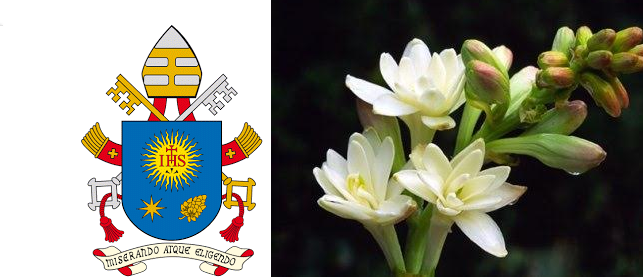“Lower down on the shield there is a star and spikenard flower. The star, according to ancient armorial tradition, symbolizes the Virgin Mary, the Mother of Christ and the Church; while the spikenard symbolizes St Joseph, Patron of the Universal Church. In traditional Hispanic iconography, St Joseph is shown with a vine in his hand. By bearing these images on his shield, the Pope communicates his special devotion to the Most Holy Virgin and to St Joseph.”
Here, in the description of Pope Francis’ coat of arms, that of when he was Archbishop of Buenos Aires, which he chose to keep when elected Successor of Peter, we hear about the spikenard flower plant.
Pope Francis is said to have wanted it to be part of his coat of arms as archbishop, as he always been especially fond of St. Joseph.
However, other than knowing it is on the Pope’s shield and that we have seen St. Joseph holding it, we still know rather little. Zenit, therefore, decided to take a closer look at this plant and its significance for the Argentine Pontiff, who celebrated the four-year anniversary of the inauguration of Francis’ pontificate yesterday, Sunday March 19, 2017.
First of all, spikenard, also referred to as nard, is a flowering plant of the Valerian family which grows in the Himalayas of India, Nepal, and China.
The oil it produces we have heard often in a Biblical context. Preserved in alabaster boxes, this expensive aromatic ointment’s chief ingredient is said to have been derived from Nardostachys jatamansi.
Since ancient times, from India to Europe, Nardostachys jatamansi oil has been used as a perfume, but also in religious and medicinal contexts.
In the Hispanic iconographic tradition, in fact, St Joseph is depicted with a branch of spikenard in his hand.
In both the Old Testament and the New Testament, the Bible contains several references to the spikenard, as a flower that gives a precious perfume which we hear about in the Gospel.
In the Old Testament, we see references to the spikenard plant, especially in Solomon’s Song of Songs.
In the Gospel, we see various references, including in Mark 14, Matthew 26, and John 12, with the Anointing at Bethany, where some presume Mary of Bethany to be Mary Magdalene, who, therefore, often is depicted with an alabaster jar of nard.
****
Some Biblical Excerpts:
NEW TESTAMENT (GOSPEL):
MARK Chapter 14:
The Anointing at Bethany.
3 When he was in Bethany reclining at table in the house of Simon the leper,b a woman came with an alabaster jar of perfumed oil, costly genuine spikenard. She broke the alabaster jar and poured it on his head.
MATTHEW Chapter 26
The Anointing at Bethany.
*6 Now when Jesus was in Bethany in the house of Simon the leper,
7a woman came up to him with an alabaster jar of costly perfumed oil, and poured it on his head while he was reclining at table.
8 When the disciples saw this, they were indignant and said, “Why this waste?
9 It could have been sold for much, and the money given to the poor.”
10 Since Jesus knew this, he said to them, “Why do you make trouble for the woman? She has done a good thing for me.
11d The poor you will always have with you; but you will not always have me.12* In pouring this perfumed oil upon my body, she did it to prepare me for burial.
JOHN: Chapter 12:3
The Anointing at Bethany.
a1* Six days before Passover Jesus came to Bethany, where Lazarus was, whom Jesus had raised from the dead.b
2 They gave a dinner for him there, and Martha served, while Lazarus was one of those reclining at table with him.c
3 Mary took a liter of costly perfumed oil made from genuine aromatic nard and anointed the feet of Jesus* and dried them with her hair; the house was filled with the fragrance of the oil.d
***
OLD TESTAMENT:
SONG OF SONGS: 1:12
12 While the king was upon his couch, my spikenard* gave forth its fragrance.
SONG OF SONGS 4: 13-14
13 Your branches are a grove of pomegranates,
with fruits of choicest yield:
Henna with spikenard,
14 spikenard and saffron,
Sweet cane and cinnamon,
with all kinds of frankincense;
Myrrh and aloes,
with all the finest spices.



